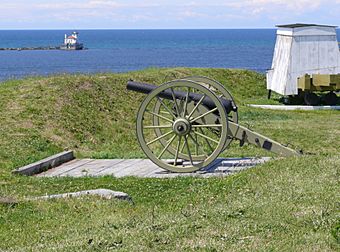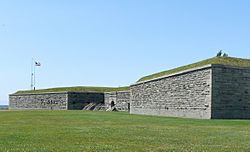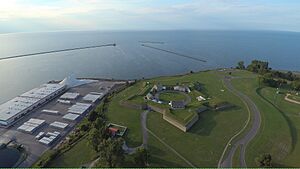Fort Ontario facts for kids
|
Fort Ontario
|
|

View from Fort Ontario
|
|
| Location | 1 E. 4th St. and Lake Ontario, Oswego, New York |
|---|---|
| Area | 36 acres (15 ha) |
| Built | 1839 |
| NRHP reference No. | 70000426 |
Quick facts for kids Significant dates |
|
| Added to NRHP | December 18, 1970 |
Fort Ontario is an old, important fort in Oswego, New York. It sits on a hill next to the Oswego River, looking out over Lake Ontario. Today, it's a museum called the Fort Ontario State Historic Site, owned by New York State.
Contents
Fort Ontario's Early History
The British built Fort Ontario in 1755 during the French and Indian War. It was one of many forts they built to protect the eastern part of Lake Ontario. The fort was meant to make the defenses stronger at Fort Oswego, which was on the other side of the river.
At first, it was called the "Fort of the Six Nations." But in 1756, French forces attacked and destroyed it during the Battle of Fort Oswego. The British rebuilt the fort in 1759.
After Pontiac's War ended, the Native American leader Pontiac met with William Johnson at Fort Ontario. They signed a peace treaty on July 25, 1766.
During the American Revolutionary War, American soldiers destroyed the fort in July 1778 after the British left it. The British came back and rebuilt it in 1782. Even after the war ended, the British kept control of the fort until 1796, when they finally handed it over after signing Jay's Treaty.
Fort Ontario in the 1800s
The British attacked and destroyed Fort Ontario again in 1814 during the War of 1812. After this, the fort was not used for a while.
Later, new construction began at the fort. This was partly because of new tensions with Great Britain. It was also to help stop people from illegally bringing goods between Canada and the United States.
During the American Civil War, more building work started at the fort. This was because people worried that Britain might help the Confederacy. After the Civil War, a group of wounded soldiers from the war lived at the fort. They had joined the U.S. Army again. Even though the fort was still a military base, the old fort buildings started to fall apart. Money was used to build more modern living areas outside the fort instead.
Fort Ontario in the 1900s
When the United States joined World War I in April 1917, Fort Ontario became a military hospital. It was called General Hospital No. 5. Medical staff trained there before going to France.
In 1921, the fort became an infantry base again. The 28th Infantry Regiment was there first. Then, in 1933, the 2nd Brigade of the U.S. 1st Infantry Division moved in. They stayed until June 1, 1940. During this time, some of the old buildings inside the fort were fixed up. A golf course was even built on the grassy walls of the fort.
In 1940, the fort was updated to be a place where new soldiers would join the army. They built 60 new buildings for 3,000 men. However, it was used instead as a base for several National Guard anti-aircraft units. As America entered World War II, Fort Ontario became a training center for African American military police.
Later in World War II, the fort became a home for 982 Jewish refugees. They lived there from August 1944 to February 1946. The Fort Ontario Emergency Refugee Shelter was the only time the United States offered shelter to Jewish refugees during the war. After the war ended, the refugees were kept at the fort. There were disagreements about whether they should be allowed to become United States citizens. In January 1946, it was decided they could become citizens. By February, all the Jewish refugees were allowed to leave Fort Ontario.
Fort Ontario Today
The U.S. Army closed Fort Ontario after World War II. However, some of its buildings are still used for training by the Army Reserve.
The restored fort is now open to the public as a state historic site. It was added to the National Register of Historic Places in 1970. In 2010, Fort Ontario was one of the historical sites that faced possible funding cuts. This was due to budget problems in New York State. In response, many people from Oswego and students from the State University of New York at Oswego worked together to support the historic site.
The Safe Haven Holocaust Refugee Shelter Museum is located in a building just south of the fort.
What Fort Ontario Looks Like
The fort you see today has a five-sided shape with five strong corners called bastions. It was designed for large cannons that would fire over the walls. However, smaller cannons called howitzers were placed inside special rooms built into the fort's walls. The stone walls of the bastions also had small openings for rifle fire. These openings were different shapes, depending on which engineers were working on the fort. Originally, a separate protective wall called a ravelin stood in front of the side facing Lake Ontario. It also held heavy guns.
Inside the fort today, you can see Officer Quarters #1, the Powder Magazine, the Enlisted Men's Barracks, the Storehouse, and Officer Quarters #2. There are also two guardhouses near the entrance to the tunnel that leads to the main entrance.
See Also







